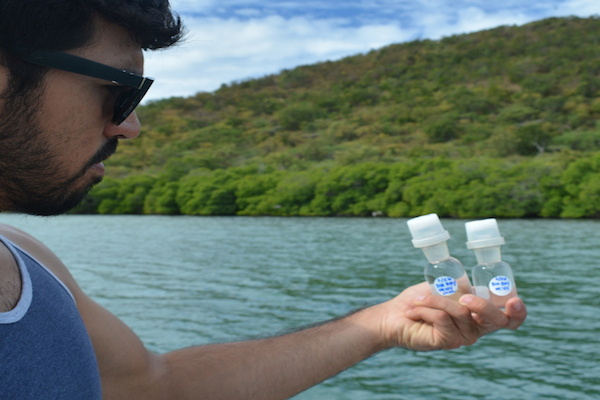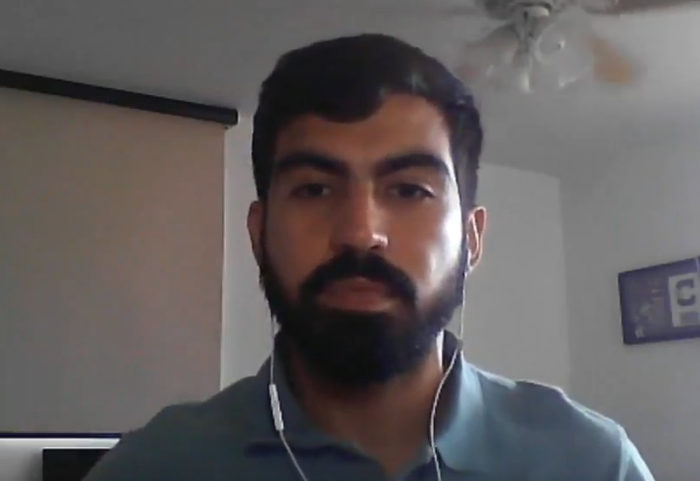Previously published by RUM Press
By Ídem Osorio De Jesús ( idem.osorio@upr.edu )
Friday, May 7, 2021, Erick Manuel García Troche, a graduate of the Mayagüez Campus (RUM) of the University of Puerto Rico (UPR), managed to share the findings of his research on the Bioluminescent Bay of La Parguera through the publication of his article in the prestigious journal scientific PLOS ONE, an open-access platform that seeks to empower researchers to make their work known immediately to promote the progress of science.
Graduated with a bachelor’s degree in Chemistry and the curricular sequence in Meteorology, in 2014, as well as a master’s degree in Marine Sciences in Chemical Oceanography, during 2020, both degrees from the RUM, the scientist reiterated the immense satisfaction that this goal achieved in his career gives him.
His article, entitled Carbonate chemistry seasonality in a tropical mangrove lagoon in La Parguera, Puerto Rico, has been available on the official PLOS ONE website since May 5, 2021, and includes a summary of what was his master’s thesis focused on the acidification of the oceans, specifically of these coastal waters.
“For me, it has great relevance because it is an accessible magazine for everyone, anyone can see the information, without having to be a member, or pay a subscription or buy it. I think it is important that these results are available without limits. You simply enter the page, access the article and you can share it with whoever you want. It is a way of communicating that science is changing today ”, he revealed.
As a graduate student and until recently, Erick worked as an assistant researcher at the Caribbean Coastal Ocean Observing System (CARICOOS), of the RUM, where he conducted his study under the advice of Professor Julio Morell, co-author of the article. Likewise, he highlighted the mentors and co-authors Melissa Meléndez, who is doing her post-doctorate at the University of Hawaii; and Joseph Salisbury, a researcher at the University of New Hampshire.
“I did my master’s degree in Ocean Acidification, focused on the Bioluminescent Bay. These studies began in the open ocean, but now they have been moving towards the coast because there are more complex processes that are being tried to understand. So we established the variability over an extended period, of four or five years, to see how the acidification levels change in those waters of La Parguera, an area on which there is not much research related ”, he explained.
The chemical oceanographer, who thanked the grant from CARICOOS and the National Oceanographic and Atmospheric Administration (NOAA) for conducting this study, added that his main interest was to understand how ocean chemistry varies in coastal areas, where there is usually more complexity due to a large number of organisms.
“Ocean acidification is directly related to climate change because it occurs due to increases in carbon dioxide (CO2) in the atmosphere. Some of it dissolves in the ocean, lowering its pH. This affects many organisms, some of the corals, oysters, mollusks. It can also impact flora, plants, and algae, among others. As there is more marine life on the coast, this acidification is more marked, “he said.
The scientist highlighted that part of the motivation for his research lies in the fact that in recent years several studies have proposed that some mangrove ecosystems could generate enough buffering capacity to correct the reduction in pH in coastal areas as a consequence of ocean acidification. According to their findings, this does not apply to the Bioluminescent Bay in La Parguera, where the pH is lower than in adjacent ocean waters 80 percent of the year. This acidification is even more severe during the rainy season between August and November.
“In my master’s thesis, it is reflected that this more intense level of acidification in the coastal area is since there is more organic matter that degrades and due to certain chemical reactions acid is produced and the pH decreases. In the Bay, we find that the acidification is stronger after the summer between August and November, due to different factors, such as rain runoff. To put it in context, the global ocean pH is 8.1, on average. And in Bioluminescent Bay we find that it is 7.6. Numerically, it doesn’t seem like a lot, but on the pH scale, the difference is very big in terms of acidity ”, he assured.
The writing that he submitted to the PLOS ONE magazine is only a summary of the full content of his project, however, he admitted that it was an enriching experience that allowed him to validate his investigative feat.
“It is a short article, but it has a lot of value in my field of Marine Sciences. They worked intensively on that writing and seeing that it is published is very gratifying. When you work hard for something and you see that it is finally finished and it is clear, it feels very good, “he said.
And how is it that a chemist became interested in pursuing a graduate school in Marine Sciences and Oceanography? Asked RUM Press.
“When I completed my bachelor’s degree in Chemistry, I always had an idea that I wanted to do my master’s degree in something related to that science, but more an application, not directly in pure chemistry. I’ve always had a passion for the ocean, I grew up on the beach because I’m from Cabo Rojo, I love the sea. I had an opportunity at CARICOOS before I graduated from high school and it was perfect, it fell like a glove. I decided to do a Master’s in Marine Sciences and it was the best ”, he said.
Precisely, Erick expressed his gratitude for the opportunity to work in the entity, dedicated to the coastal observation of the American Caribbean, whose mission is to satisfy the needs of data related to the ocean to the users of the area through the use of buoys and meteorological stations, among others.
“Everything I know, I owe to CARICOOS and my mentors. I would not be where I am without them, definitely, “he said.
Regarding his career through the Mayaguez campus of the UPR, this versatile graduate highlighted the importance of going further and taking advantage of the different platforms available for professional growth.
“My education was excellent and the teachers were very good too. I was able to participate in many internships for the programs I studied that are well specialized, such as Meteorology, which is only offered at the RUM. In many of them, I did not have to pay anything, as they were financed with federal funds. I also played in the volleyball team at the College, a sport that teaches you a lot about group work, effort, dedication, and discipline. It was challenging having to balance research with classes, being an athlete, plus the additional responsibilities, but at the same time, it helps you develop many facets that are later reflected in the fruits of your career, “he said.
Regarding the curricular sequence in Meteorology, he stressed that it has provided many fruits for Puerto Rico and many quality professionals because it offers a complete preparation in the discipline.
“My first research was at the RUM with a professor of Electrical Engineering. We worked to find areas around Puerto Rico where the radar in Cayey had better vision. The other internship I did at the National Weather Service in Brownsville, Texas. That is right on the border with Mexico, and there we focus on improving wind warnings for the region. My last internship was more in Atmospheric Sciences because I did it at the Arecibo Observatory, where we concentrated on understanding the layers of metals, when meteorites, stones, or any alien object enter the Earth. I studied the layers of sodium in the upper atmosphere ”, he recalled, while lamenting the loss of the Observatory due to its relevance to the scientific community worldwide.
Although he has contemplated the idea of completing a PhD, at this moment he is focused on contributing his knowledge from the labor field. After his experience with CARICOOS, the scientific entrepreneur started a new job with a non-profit organization, where he will be the coordinator of research and marine operations.
“In the long term, I would like to make a significant contribution to the future of my country. I want to continue in the investigation and I understand that with this new opportunity I will be able to continue that goal, “he said.
The full article can be found on the PLOS ONE page.





